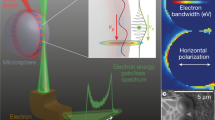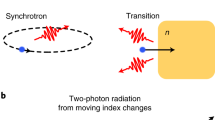Abstract
Anderson localization of light has been demonstrated in a few different dielectric materials and lithographically fabricated structures. However, such localization is difficult to control, and requires strong magnetic fields or nonlinear optical effects, and electronic control has not been demonstrated. Here, we show control of optical Anderson localization using charge carriers injected into more than 100 submicrometre-scale p–n diodes. The diodes are embedded into the cross-section of the optical waveguide and are fabricated with a technology compatible with the current electronics industry. Large variations in the output signal, exceeding a factor of 100, were measured with 1 V and a control current of 1 mA. The transverse footprint of our device is only 0.125 µm2, about five orders of magnitude smaller than optical two-dimensional lattices. Whereas all-electronic localization has a narrow usable bandwidth, electronically controlled optical localization can access more than a gigahertz of bandwidth and creates new possibilities for controlling localization at radiofrequencies, which can benefit applications such as random lasers, optical limiters, imagers, quantum optics and measurement devices.
This is a preview of subscription content, access via your institution
Access options
Subscribe to this journal
Receive 12 print issues and online access
$259.00 per year
only $21.58 per issue
Buy this article
- Purchase on Springer Link
- Instant access to full article PDF
Prices may be subject to local taxes which are calculated during checkout





Similar content being viewed by others
References
Wiersma, D. S. Disordered photonics. Nature Photon. 7, 188–196 (2013).
Sapienza, L. et al. Cavity quantum electrodynamics with Anderson-localized modes. Science 327, 1352–1355 (2010).
Crespi, A. et al. Anderson localization of entangled photons in an integrated quantum walk. Nature Photon. 7, 322–328 (2013).
Redding, B., Liew, S. F., Sarma, R. & Cao, H. Compact spectrometer based on a disordered photonic chip. Nature Photon. 7, 746–751 (2013).
Wiersma, D. S., Bartolini, P., Lagendijk, A. & Righini, R. Localization of light in a disordered medium. Nature 390, 671–673 (1997).
Störzer, M., Gross, P., Aegerter, C. M. & Maret, G. Observation of the critical regime near Anderson localization of light. Phys. Rev. Lett. 96, 063904 (2006).
Schwartz, T., Bartal, G., Fishman, S. & Segev, M. Transport and Anderson localization in disordered two-dimensional photonic lattices. Nature 446, 52–55 (2007).
Topolancik, J., Ilic, B. & Vollmer, F. Experimental observation of strong photon localization in disordered photonic crystal waveguides. Phys. Rev. Lett. 99, 253901 (2007).
Mookherjea, S., Park, J. S., Yang, S. H. & Bandaru, P. R. Localization in silicon nanophotonic slow-light waveguides. Nature Photon. 2, 90–93 (2008).
Lahini, Y. et al. Anderson localization and nonlinearity in one-dimensional disordered photonic lattices. Phys. Rev. Lett. 100, 013906 (2008).
Kenke, R. & Maret, G. Affecting weak light localization by strong magnetic fields. Physica Scripta T49, 605–609 (1993).
Liu, H-Y. et al. Self-induced Anderson localization and optical limiting in photonic crystal coupled cavity waveguides with Kerr nonlinearity. Appl. Phys. Lett. 90, 213507 (2007).
Giamarchi, T. & Schulz, H. J. Anderson localization and interactions in one dimensional metals. Phys. Rev. B 37, 325–340 (1998).
Pendry, J. Symmetry and transport of waves in one-dimensional disordered systems. Adv. Phys. 43, 461–542 (1994).
Vandamme, L. K. J. & Hooge, F. N. What do we certainly know about noise in MOSTs? IEEE Electron. Dev. Lett. 55, 3070–3085 (2008).
Forbes, L. On the theory of 1/f noise of semi-insulating materials. IEEE Electron. Dev. Lett. 42, 1866–1868 (1995).
Fetter, A. L. & Walecka, J. D. Theoretical Mechanics of Particles and Continua (McGraw-Hill, 1980).
Cooper, M. L. et al. Statistics of light transport in 235-ring silicon coupled-resonator optical waveguides. Opt. Express 18, 26505–26516 (2010).
Thouless, D. J. Maximum metallic resistance in thin wires. Phys. Rev. Lett. 39, 1167–1169 (1977).
Chabanov, A. A., Stoytchev, M. & Genack, A. Z. Statistical signatures of photon localization. Nature 404, 850–853 (2000).
Markos, P. & Soukoulis, C. M. Intensity distribution of scalar waves propagating in random media. Phys. Rev. B 71, 054201 (2005).
Kogan, E. & Kaveh, M. Random-matrix-theory approach to the intensity distributions of waves propagating in a random medium. Phys. Rev. B 52, R3813 (1995).
Van Rossum, M. C. W. & Nieuwenhuizen, T. M. Multiple scattering of classical waves: microscopy, mesoscopy, and diffusion. Rev. Mod. Phys. 71, 313–371 (1997).
Poon, J. K. S. et al. Matrix analysis of microring coupled-resonator optical waveguides. Opt. Express 12, 90–103 (2004).
Xia, F., Rooks, M., Sekaric, L. & Vlasov, Y. Ultra-compact high order ring resonator filters using submicron silicon photonic wires for on-chip optical interconnects. Opt. Express 15, 11934–11941 (2007).
Cooper, M. & Mookherjea, S. Modeling of multiband transmission in long silicon coupled-resonator optical waveguides. IEEE Photon. Technol. Lett. 23, 872–874 (2011).
Markos, P. Numerical analysis of the Anderson localization. Acta Physica Slovaca 56, 561–685 (2006).
Soref, R. A. & Bennett, B. Electrooptical effects in silicon. IEEE J. Quantum Electron. 23, 123–129 (1987).
Xu, Q., Schmidt, B., Pradhan, S. & Lipson, M. Micrometre-scale silicon electro-optic modulator. Nature 435, 325–327 (2005).
Leong, E. & Yu, S. UV random lasing action in p-SiC(4H)/i-ZnO–SiO2 nanocomposite/n-ZnO:Al heterojunction diodes. Adv. Mater. 18, 1685–1688 (2006).
Chu, S., Olmedo, M., Yang, Z., Kong, J. & Liu, J. Electrically pumped ultraviolet ZnO diode lasers on Si. Appl. Phys. Lett. 93, 181106 (2008).
Zhu, H. et al. Low-threshold electrically pumped random lasers. Adv. Mater. 22, 1877–1881 (2010).
Basko, D., Aleiner, I. & Altshuler, B. Metal–insulator transition in a weakly interacting many-electron system with localized single-particle states. Ann. Phys. 321, 1126–1205 (2006).
Vlasov, Y. A., O'Boyle, M., Hamann, H. F. & McNab, S. J. Active control of slow light on a chip with photonic crystal waveguides. Nature 438, 65–69 (2005).
Green, W. M., Rooks, M. J., Sekaric, L. & Vlasov, Y. A. Ultra-compact, low RF power, 10 Gb/s silicon Mach–Zehnder modulator. Opt. Express 15, 17106–17113 (2007).
Mahler, L. et al. Quasi-periodic distributed feedback laser. Nature Photon. 4, 165–169 (2010).
Deng, C-S., Xu, H. & Deych, L. Effect of size disorder on the optical transport in chains of coupled microspherical resonators. Opt. Express 19, 6923–6937 (2011).
Acknowledgements
The authors thank J.B. Pendry, D. Wiersma, P. Lodahl, C. Lopez, Y. Vlasov and H. Cao for discussions. This work was supported by the US National Science Foundation (grants ECCS 092539, 1028553, 1153716 and 1201308) and the Center for Integrated Access Networks—a National Science Foundation Engineering Research Center. J.R.O. acknowledges support from the Agency for Science, Technology and Research (A*STAR), Singapore. All statements of fact, opinion or conclusions contained herein are those of the authors and should not be construed as representing the official views or policies of the US Government.
Author information
Authors and Affiliations
Contributions
S.M. conceived the study, coordinated the project and wrote the manuscript with input from all authors. J.R.O. designed the lithographic layout for the devices, which were fabricated by X.L. and L.G.Q. Measurements were performed by S.M. and J.R.O. All authors reviewed the manuscript.
Corresponding author
Ethics declarations
Competing interests
The authors declare no competing financial interests.
Supplementary information
Supplementary information
Supplementary Information (PDF 1531 kb)
Rights and permissions
About this article
Cite this article
Mookherjea, S., Ong, J., Luo, X. et al. Electronic control of optical Anderson localization modes. Nature Nanotech 9, 365–371 (2014). https://doi.org/10.1038/nnano.2014.53
Received:
Accepted:
Published:
Issue Date:
DOI: https://doi.org/10.1038/nnano.2014.53
This article is cited by
-
Anderson localization of flexural waves in disordered elastic beams
Scientific Reports (2019)
-
Lattice topology dictates photon statistics
Scientific Reports (2017)
-
Direct observation of Anderson localization in plasmonic terahertz devices
Light: Science & Applications (2016)
-
Localizing light with electrons
Nature Nanotechnology (2014)



